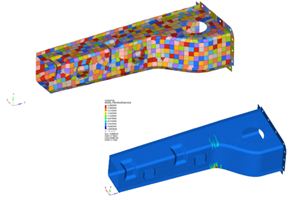Detroit Auto Show
2007 NAIAS exhibition spotlights new composites applications.
The 2007 North American International Auto Show, held Jan. 13-21 at the Cobo Conference/Exhibition Center in Detroit, Mich., once again served as the leading showcase for production and concept vehicle introductions from domestic and international OEMs. A number of hybrid vehicles were featured, reflecting the industry's increasing awareness of environmental concerns, such as global warming. Among them was General Motors' Volt concept car, with batteries and electric motors capable of running up to 40 miles (64 km) on a single six-hour charge before its small gasoline engine kicks in to generate sufficient electricity to power the motors until the car's batteries can be recharged. Because many people drive less than this distance most days, it is possible that a tank of fuel could last a very long time, provided the car's owner remembers to plug the vehicle in at night. Notable for the number of plastic and composite components used on the concept, the Volt may or may not see production (if yes, possibly by 2010) and could differ significantly in terms of material use (see “Related Content,” at left).
Concurrent with the event, the Automotive Composites Alliance (ACA) held a daylong reception at a venue adjacent to Cobo Hall, featuring composite components and the chance to learn more about the materials and methods used to produce them. SMC is still the predominant composite material used on production automobiles, and a number of material and process advances have been made in materials and processing, which are covered in more detail in the feature article on p. 30. One new SMC application highlighted by the ACA was the hood for the 2008 model Dodge Viper. Although previously made of SMC, the hood was restyled during a mid-cycle upgrade of the vehicle to accommodate an 8.4L V-10 engine with larger cylinder bores, a modification that enables production of more than 600 hp. Molded by Meridian Automotive Systems (Allen Park, Mich.), the hood now includes an integrally molded front scoop and larger louvers. The outer skin is standard low-profile, Class A SMC, and the bonded inner panel is a low-density (1.3 g/cm3) structural SMC. Other recent SMC introductions include a hood for the Lincoln Navigator, molded by Continental Structural Plastics (formerly Budd Plastics, Troy, Mich.), and vinyl ester valve covers for the 13L diesel engines in Mack Truck and Cummins heavy trucks.
An interesting new hybrid composite introduction was the "Divide-N-Hide"trunk divider, available on some Nissan Sentra models. This flip-down panel, also molded by Meridian Automotive Systems, is installed about 12 inches/300 mm behind the back seat, creating a compartment that can be used to stow seldom-used or valuable items. Meridian director of engineering Tyler Hardy says the divider comprises two bonded panels. The forward panel (visible when the back seat is folded down) and latch housing must meet dynamic impact loads caused by sudden stops or accelerations, and are molded from structural 30 percent glass SMC with molded-in color. The assembly's trunk side panel is a polypropylene/flax fiber composite with molded-on carpet.
Directed fiber preforming is increasing in structural applications says Keith Bihary, automotive sales manager for Molded Fiber Glass Cos. (MFG, Ashtabula, Ohio) and the 2007 ACA chairman. Termed "positive glass placement"by MFG, the process yields components with less mechanical property variance than SMC, thanks mainly to robotic placement of the fibers prior to resin addition and compression molding. The Saturn Sky, Dodge Viper, Pontiac Solstice and Chevrolet Corvette all use structural components molded via the process. On the Corvette Z06, the floor panels and wheelhouses are made using the process and incorporate carbon fiber for 40 percent weight savings. Bihary says that, despite the current shortage of aerospace grade carbon fiber, interest in carbon is growing, in part because MFG engineers have developed techniques to use more readily available commercial-grade (large tow) carbon fiber.
Related Content
Johns Manville launches multi-end roving MultiStar 272
Multi-end fiberglass roving serves as a reliable product for SMC compounders aiming to excel in automotive applications.
Read MoreSMC simulation tool enhances design optimization
CAMX 2023: FiRMA, Engenuity’s new approach to SMC, uses a predictive technique that accurately reflects material properties and determine the performance range an SMC part or structure will exhibit.
Read MoreWAG Wernli to produce composite brackets for Dufour Aero2 drone
The Swiss company was chosen for its C-SMC expertise, which will replace original aluminum brackets to enhance weight savings, corrosion resistance and adhesive bonding capabilities.
Read MoreIDI Composites opens new global headquarters, manufacturing and technology center
The Noblesville, Indiana, facility includes SMC and BMC manufacturing, an R&D center and the company’s corporate headquarters.
Read MoreRead Next
Developing bonded composite repair for ships, offshore units
Bureau Veritas and industry partners issue guidelines and pave the way for certification via StrengthBond Offshore project.
Read MoreVIDEO: High-volume processing for fiberglass components
Cannon Ergos, a company specializing in high-ton presses and equipment for composites fabrication and plastics processing, displayed automotive and industrial components at CAMX 2024.
Read MorePlant tour: Daher Shap’in TechCenter and composites production plant, Saint-Aignan-de-Grandlieu, France
Co-located R&D and production advance OOA thermosets, thermoplastics, welding, recycling and digital technologies for faster processing and certification of lighter, more sustainable composites.
Read More


















